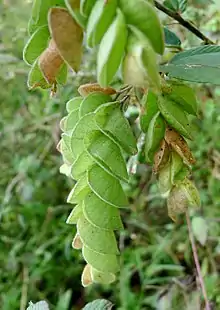| Flemingia | |
|---|---|
 | |
| Flemingia strobilifera | |
| Scientific classification | |
| Kingdom: | Plantae |
| Clade: | Tracheophytes |
| Clade: | Angiosperms |
| Clade: | Eudicots |
| Clade: | Rosids |
| Order: | Fabales |
| Family: | Fabaceae |
| Subfamily: | Faboideae |
| Tribe: | Phaseoleae |
| Subtribe: | Cajaninae |
| Genus: | Flemingia Roxb. ex W. T. Aiton (1812), nom. cons. |
| Species | |
|
See text | |
| Synonyms[1] | |
| |
Flemingia is a genus of plants in the family Fabaceae. It is native sub-Saharan Africa, Yemen, tropical Asia, and Australasia.[1] In Asia the species are distributed in Bhutan, Burma, China, India; Indonesia, Laos, Malaysia, Nepal, Pakistan, Papua New Guinea, Philippines, Sri Lanka, Taiwan, Thailand and Vietnam.[2][3] The genus was erected in 1812.
Description
Members of Flemingia are shrubs, or herbs (or subshrubs); evergreen, or deciduous and perennial. They are generally about 0.2–1.5 m high. The stem is prostrate but weak. Leaves are small to medium-sized; not fasciculate, but alternate. The stem and leaves are pubescent, with dense hairs. Leaf blades are flat dorsoventrally. Flowers are aggregated in ‘inflorescences’; not crowded at the stem bases; in racemes, or in heads, or in panicles. Fruits are aerial, about 6–15 mm long; non-fleshy and hairy.[4][5][6]
Diversity
The number of known species is ambiguous due to taxonomic problems; and is usually enumerated as more than 30. Burma and China have the highest record of Flemingia species with 16 each, followed by India (with 15 species), Thailand (11 species), Laos (10 species), Vietnam (8 species), Bhutan (1 species) and Nepal (5 species).[7] Plants of the World Online accepts 46 species.[1]
Uses
Root tubers of Flamingia species have traditionally been used as food for Aborigines of the Northern Territory.[8]
Traditional use
Some species of Flemingia are used in the herbal medicine traditions of various Asian communities. This is attributed to their unique chemical properties, especially those of flavonoids and sterols. Their most common applications in traditional medicine are for epilepsy, dysentery, stomach ache, insomnia, cataract, helminthiasis, rheumatism, ulcer, and tuberculosis.
Species
46 species are accepted.[1]
- Flemingia angusta Craib
- Flemingia angustifolia Roxb.
- Flemingia bhutanica Grierson
- Flemingia bracteata (Roxb.) Wight
- Flemingia chappar Buch.-Ham. ex Benth.
- Flemingia cumingiana Benth.
- Flemingia faginea (Guill. & Perr.) Baker
- Flemingia fluminalis C.B.Clarke ex Prain
- Flemingia fruticulosa Wall. ex Benth.
- Flemingia gracilis (Mukerjee) Ali
- Flemingia grahamiana Wight & Arn.
- Flemingia horsfieldii Blume ex Miq.
- Flemingia javanica C.Y.Wu
- Flemingia kerrii Craib
- Flemingia kweichowensis Tang & F.T.Wang ex Y.T.Wei & S.K.Lee
- Flemingia lacei Craib
- Flemingia langbiangensis T.V.Do, B.Xu & X.F.Gao
- Flemingia latifolia Benth.
- Flemingia lineata (L.) Roxb. ex W.T.Aiton
- Flemingia macrophylla (Willd.) Kuntze ex Merr.
- Flemingia mengpengensis Y.T.Wei & S.K.Lee
- Flemingia mukerjeeana S.K.Gavade, Survesw., Maesen & Lekhak
- Flemingia nana Roxb. ex W.T.Aiton
- Flemingia nilgheriensis (Benth. ex Baker f.) Wight ex T.Cooke
- Flemingia paniculata Wall. ex Benth.
- Flemingia parviflora Benth.
- Flemingia pauciflora Benth.
- Flemingia praecox C.B.Clarke ex Prain
- Flemingia procumbens Roxb.
- Flemingia prostrata Roxb.Junior ex Roxb.
- Flemingia rollae (Billore & Hemadri) Anand Kumar
- Flemingia semialata Roxb. ex W.T.Aiton
- Flemingia sirindhorniae Mattapha, Chantar. & Suddee
- Flemingia sootepensis Craib
- Flemingia stricta Roxb.
- Flemingia strobilifera (L.) W.T.Aiton
- Flemingia teysmanniana Miq.
- Flemingia tiliacea Niyomdham
- Flemingia trifoliastrum Domin
- Flemingia trifoliata (Jungh.) C.Y.Wu
- Flemingia tuberosa Dalzell
- Flemingia vestita Benth. ex Baker f.
- Flemingia wallichii Wight & Arn.
- Flemingia weii T.V.Do & X.F.Gao
- Flemingia wightiana Graham ex Wight & Arn.
- Flemingia yunnanensis Franch.
References
- 1 2 3 4 Flemingia Roxb. ex W.T.Aiton. Plants of the World Online. Retrieved 24 August 2023.
- ↑ Lewis G, Schrire B, MacKinder B, Lock M (2005). Legumes of the World. The Royal Botanic Gardens, Kew. p. 529. ISBN 1900347806.
- ↑ National Research Council (2002). Tropical Legumes: Resources for the Future. Books for Business/ The Minerva Group, Inc. pp. 37–38. ISBN 0894991922.
- ↑ Watson L (2008). Scientific Description: Flemingia W.T. Aiton. The Royal Botanic Gardens, Kew.
- ↑ Chaudhri AB (2005). Forests Plants of Eastern India. Ashish. pp. 205–206. ISBN 8170245370.
- ↑ Ren S, Gilbert MG (2010). "FLEMINGIA Roxburgh ex W. T. Aiton, Hort. Kew., ed. 2, 4: 349. 1812, nom. cons., not Roxburgh ex Rottler (1803)" (PDF). Flora of China. 10 (3): 232–237. ISSN 1043-4534.
- ↑ Mishra S (2001). "Revision of the genus Flemingia Roxb. ex. W.T. Aiton, nom.cons. (Leguminosae) in Nepal". Botanica Orientalis. 4 (1): 458.
- ↑ NTFlora Northern Territory Flora online: Flora of the Darwin Region: Fabaceae. Retrieved 10 June 2018
External links
- Classification at Botanica Sistematica
- Plant Profile at USDA Plant Database
- ITIS Report
- Taxonomy at UniProt
- Classification at Encyclopedia of Life
- "Flemingia strobilifera". Germplasm Resources Information Network. Agricultural Research Service, United States Department of Agriculture.
- NCBI Taxonomy Browser
- Plantillustrations